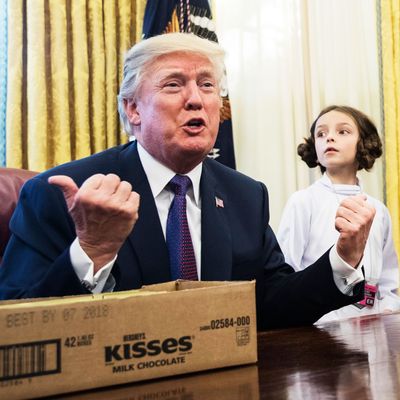
By now, we have all seen video evidence of the gaspingly odd meeting between our president and a group of youngsters in Halloween costumes. In the Land of Regular Human Beings, any adult encountering miniature Princess Leias or a tiny Batman would predictably respond with simple, warm conversation, a brief inquiry about costume choice, and maybe some affectionate joshing.
But the president could not communicate with his visitors, speaking to them instead in the only language he knows: ridicule (for their parents, all members of the press corps), assessments of their physical appearance, and references to himself (his perceived mistreatment by the children’s journalist parents).
Forget North Korea; we now know that the president’s diplomacy skills are inadequate for a Halloween photo op. But the children’s White House visit taught us more than that.
In America, Halloween is largely a fashion holiday for children: a day of dress-up, disguise, and role-play. A day to break free from the limited role of “child” and indulge in the fantasy of being a beloved film or literary character, of being magical or terrifying, and, most of all, of being powerful. Halloween allows children to turn the tables on adults and demand recognition of their own importance, demand that grownups act impressed with them.
Adults understand and react accordingly, playing along with the scenario. We recoil in mock horror at the witches and skeletons; we marvel at the butterflies or fairy princesses. To meet a trick-or-treater is to engage in this moment of improvisatory theater. A few years ago, upon being “zapped” by a toddler Spiderman, President Obama instantly staggered theatrically backward — a moment captured in a famous photo.
But Donald Trump resolutely resisted the theatrical demands of his trick-or-treaters. He did not acknowledge their costumes or characters; he did not pretend to be scared or impressed. In other words, he would not — or could not — cede his adult power to these young princesses and superheroes. He would not even pretend to relinquish the reins of authority. And here’s why: In order to play at shedding your power, you need to be confident of putting it back on again. You need to be enough at ease with your own authority to set it aside for a moment.
Trump cannot do this. He could not play-act appropriately with costumed children because he himself is also ‘in costume,’ dead set on play-acting the role of competent President. He is holding on far too tightly to the trappings of that character ever to risk letting them go.
Evidence of the strain Trump experiences in playing this character abounds. We see it in the way he demands adulation from his staff. Like a trick-or-treater, our president routinely requires a charade of deference and fear from those around him, commanding others to confirm his power and thereby announcing his own insecurity about it.
Trump’s physicality also suggests “costume.” Consider his hair alone: how oddly long he lets his gray roots grow into the dyed area, or the peculiarly overarranged coiffure he sports, so easily undone by a breeze. Note the masklike effect of his imperfectly applied bronzer — with circular white “cutouts” for his eyes, or his oddly long ties.
The appearance of obviously costumed children in his office threatened and exposed the precariousness of Trump’s own disguise. Their innocent display of pretend power held a mirror up to his own cobbled-together presidential disguise, revealing Trump to be playing nearly as much a Halloween role as they were. The kids will go home and step out of their fictional roles; Trump stays in his 24/7.
It’s also worth noting that in their costumes, the children — albeit adorable — hewed disappointingly closely to gender stereotypes: among the girls, I counted two Princess Leias, a little winged fairy, and several witches; the boys all seemed to be superheroes. In other words, the girls occupied the usual points on the female-power spectrum: vixen, pixie, and crone, while the boys aspired to superhuman strength and heroism — a dispiriting reminder of the usual limited range we see every Halloween.
And while he failed to engage meaningfully with any of the kids, Trump did return repeatedly to their physical appearances, exclaiming over their beauty and even assessing their weight (deeming them slim enough to be permitted Halloween candy). His words chillingly recall that, to Trump, those below him in authority — in this case children, though often it’s women — are little more than objects to assess physically, possessions to admire or exchange.
Halloween — a celebration of disguise and pretense — wound up exposing truth and reality: a leader who cannot connect even with children, who offers off-putting mixed signals where warmth and affection should be, and who seems to hold a peculiarly objectifying view of others.
Before it became a celebration of candy and costumes, Halloween was All Hallow’s Eve — the night when spirits of the dead returned to roam among the living. It served as a reminder of the awesome power of the human soul, a call to respect the cycle of life and death. Oddly, in his immutable solipsism, Trump inadvertently summons us to remember the holiday’s original meaning. The White House may have staged this event to score some easy political points — a few minutes of banter with children, in the spirit of our modern, superficial version of Halloween. But the plan misfired. Watching this uneasy, emotionally dissonant event, we sense the terrible wrongness in this administration and grow painfully aware of what it lacks: a feeling for our shared humanity, an instinctive appreciation of inter-generational communion — the very ideals invoked traditionally on All Hallow’s Eve. As the French poet Jean Cocteau once wrote, “The masquerade unmasks.”




